The demands that inertial fusion experiments place on their drivers have made the Lawrence Livermore National Laboratory (LLNL) National Ignition Facility (NIF) the largest laser facility in the world, including the large final optics that direct each beam to the target. A future Inertial Fusion Energy (IFE) power plant will need to provide more laser energy at a dramatically increased repetition rate, which poses two challenges: the optical components of these driving lasers must either be larger or more damage resistant to support higher energy and must be able to withstand many more shots before replacement. Since we can expect significant debris, x-ray, neutron, and backscatter fluxes from the target, protecting the final laser optics is a substantial challenge. Any effort to make a more compact laser for delivering IFE-relevant energies to target will also require a fundamental change in optics technology.
This invention concerns a new type of optic: a transient gas or plasma volume grating produced indirectly by small secondary lasers or directly by nonlinear processes using the primary beams themselves. When used in conjunction with advantageously placed shielding it offers a means of protecting the final optical components of a high-repetition-rate IFE facility. These transmission optics are based on induced index of refraction modulation in a gas or plasma and can be used for beam steering and focusing. Critically, they are orders-of-magnitude more resistant to optical damage than glass, and, since they are reformed with each shot, are not affected by debris or radiation. As a secondary benefit, their short lifetime mean they act as fast optical shutters to protect upstream laser optics from all backscattering. Using plasma and gas gratings allows all solid-state optics to be removed from target line-of-sight, improving the resilience and lifetime of any future IFE facility.
LLNL’s methods of forming transient optical components in a plasma medium for the manipulation of ultra-high power optical beams has numerous advantages over traditional fused silica-based optics, such as:
- Transient ultra-high damage threshold transmission optical components created on the fly
- Arbitrary optical functions can be configured dynamically on nanosecond timescales
- Optical functions can be re-configured at high pulse repetition rates
- Can act as fast optical shutter to protect upstream laser optics from all debris backscatter
- Dramatically improves final optics lifetime in power plant operation by shielding them from debris and fusion reaction products
LLNL’s methods of forming transient optical components in a plasma medium for the manipulation of ultra-high power optical beams has numerous applications including:
- Laser inertial confinement fusion power plants
- Ultra-high power laser beam control
Current stage of technology development: TRL 2 (December 2022)


